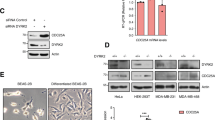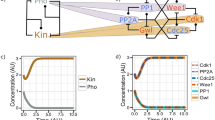Abstract
Mitotic entry, a critical decision point for maintaining genetic stability, is governed by the cyclin B/Cyclin dependent kinase 1 (Cdc2) complex. In Xenopus oocytes and early embryos, accumulation of cyclin B activates Cdk1, which then phosphorylates and activates the positive regulator Cdc25 in an autocatalytic feedback loop. However, cyclin B levels do not increase as some human cells approach mitosis, and the key factors regulating Cdk1 activation in human cells are unknown. We report here that reducing cyclin A expression by RNA interference (RNAi) in primary human fibroblasts inhibited activation of Cdc25B and Cdc25C and dephosphorylation of Cdk1 on tyrosine (tyr) 15. These results were reproduced in U2-OS cells by inducing the expression of a dominant-negative (dn) mutant of Cdk2, the principal cyclin A binding partner. Cdk2-dn induction could inhibit Cdc25B activity and foster Cdk1 tyr phosphorylation within the S phase, temporally dissociating these events from Cdk1 activation at mitosis. In contrast, reducing Cdk1 expression delayed mitotic entry without markedly impairing Cdc25B or Cdc25C activity. These results suggest that cyclin A/Cdk2 complexes are key regulators of Cdc25 and Cdk1 activation in human cells. This pathway appears to be commonly deregulated in cancer.
This is a preview of subscription content, access via your institution
Access options
Subscribe to this journal
Receive 50 print issues and online access
$259.00 per year
only $5.18 per issue
Buy this article
- Purchase on Springer Link
- Instant access to full article PDF
Prices may be subject to local taxes which are calculated during checkout




Similar content being viewed by others
References
Agami R and Bernards R . (2000). Cell, 102, 55–66.
Baldin V, Cans C, Superti-Furga G and Ducommun B . (1997). Oncogene, 14, 2485–2495.
Berthet C, Aleem E, Coppola V, Tessarollo L and Kaldis P . (2003). Curr. Biol., 13, 1775–1785.
Bulavin DV, Amundson SA and Fornace AJ . (2002). Curr. Opin. Genet. Dev., 12, 92–97.
De Bondt HL, Rosenblatt J, Jancarik J, Jones HD, Morgan DO and Kim SH . (1993). Nature, 363, 595–602.
Ellinger-Ziegelbauer H, Karasuyama H, Yamada E, Tsujikawa K, Todokoro K and Nishida E . (2000). Genes Cells, 5, 491–498.
Falck J, Petrini JH, Williams BR, Lukas J and Bartek J . (2002). Nat. Genet., 30, 290–294.
Fang F and Newport JW . (1991). Cell, 66, 731–742.
Gabrielli BG, Clark JM, McCormack AK and Ellem KA . (1997). J. Biol. Chem., 272, 28607–28614.
Gabrielli BG, De Souza CP, Tonks ID, Clark JM, Hayward NK and Ellem KA . (1996). J. Cell Sci., 109, 1081–1093.
Galaktionov K, Lee AK, Eckstein J, Draetta G, Meckler J, Loda M and Beach D . (1995). Science, 269, 1575–1577.
Goldstone S, Pavey S, Forrest A, Sinnamon J and Gabrielli B . (2001). Oncogene, 20 (8), 921–932.
Guadagno TM and Newport JW . (1996). Cell, 84, 73–82.
Hoffmann I, Clarke PR, Marcote MJ, Karsenti E and Draetta G . (1993). EMBO J., 12, 53–63.
Hu B, Mitra J, van den Heuvel S and Enders G . (2001). Mol. Cell. Biol., 21, 2755–2766.
Izumi T, Walker DH and Maller JL . (1992). Mol. Biol. Cell, 3, 927–939.
Krek W, Livingston DM and Shirodkar S . (1993). Science, 262, 1557–1560.
Kumagai A and Dunphy WG . (1992). Cell, 70, 139–151.
Kumagai A and Dunphy WG . (1996). Science, 273, 1377–1380.
Lammer C, Wagerer S, Saffrich R, Mertens D, Ansorge W and Hoffmann I . (1998). J. Cell Sci., 111, 2445–2453.
Liu X and Erikson RL . (2002). Proc. Natl. Acad. Sci. USA, 99, 8672–8676.
Maller JL . (1991). Curr. Opin. Cell Biol., 3, 269–275.
Malumbres M and Barbacid M . (2001). Nat. Rev. Cancer, 1, 222–231.
Mueller PR, Coleman TR, Kumagai A and Dunphy WG . (1995). Science, 270, 86–90.
Mundt KE, Golsteyn RM, Lane HA and Nigg EA . (1997). Biochem. Biophys. Res. Commun., 239, 377–385.
Nigg EA . (1998). Curr. Opin. Cell Biol., 10, 776–783.
Nishijima H, Nishitani H, Seki T and Nishimoto T . (1997). J. Cell Biol., 138, 1105–1116.
Norbury C and Nurse P . (1990). Ciba Found Symp., 150, 168–177, Discussion 177-83.
Novak B and Tyson JJ . (1993). J. Cell Sci., 106 (Part 4), 1153–1168.
Ortega S, Prieto I, Odajima J, Martin A, Dubus P, Sotillo R, Barbero JL, Malumbres M and Barbacid M . (2003). Nat. Genet., 35, 25–31.
Parker LL, Sylvestre PJ, Byrnes 3rd MJ, Liu F and Piwnica-Worms H . (1995). Proc. Natl. Acad. Sci. USA, 92, 9638–9642.
Poon RY, Chau MS, Yamashita K and Hunter T . (1997). Cancer Res., 57, 5168–5178.
Poon RYC, Jiang W, Toyoshima H and Hunter T . (1996). J. Biol. Chem., 271, 13283–13291.
Qian YW, Erikson E, Li C and Maller JL . (1998). Mol. Cell Biol., 18, 4262–4271.
Riabowol K, Draetta G, Brizuela L, Vandre D and Beach D . (1989). Cell, 57, 393–401.
Strausfeld U, Fernandez A, Capony JP, Girard F, Lautredou N, Derancourt J, Labbe JC and Lamb NJ . (1994). J. Biol. Chem., 269, 5989–6000.
Tetsu O and McCormick F . (2003). Cancer Cell, 3, 233–245.
Theis-Febvre N, Filhol O, Froment C, Cazales M, Cochet C, Monsarrat B, Ducommun B and Baldin V . (2003). Oncogene, 22, 220–232.
Tsai L-H, Harlow E and Meyerson M . (1991). Nature, 353, 174–177.
van den Heuvel S and Harlow E . (1993). Science, 262, 2050–2054.
Wu L, Timmers C, Maiti B, Saavedra HI, Sang L, Chong GT, Nuckolls F, Giangrande P, Wright FA, Field SJ, Greenberg ME, Orkin S, Nevins JR, Robinson ML and Leone G . (2001). Nature, 414, 457–462.
Acknowledgements
This work was supported by NIH grant 1-K01-DK61280-01 (to JM), American Cancer Society grant RPG-99-168-01-CCG (to GHE), and a University of Pennsylvania Research Foundation grant (to GHE). We thank the Morphology Core Facility of Penn's NIH Center for Molecular Studies of Gastrointestinal and Liver Diseases (grant P30 DK50306) for use of reagents and facilities.
Author information
Authors and Affiliations
Corresponding authors
Rights and permissions
About this article
Cite this article
Mitra, J., Enders, G. Cyclin A/Cdk2 complexes regulate activation of Cdk1 and Cdc25 phosphatases in human cells. Oncogene 23, 3361–3367 (2004). https://doi.org/10.1038/sj.onc.1207446
Received:
Revised:
Accepted:
Published:
Issue Date:
DOI: https://doi.org/10.1038/sj.onc.1207446
Keywords
This article is cited by
-
Targeting CDK1 in cancer: mechanisms and implications
npj Precision Oncology (2023)
-
Cyclin B/CDK1 and Cyclin A/CDK2 phosphorylate DENR to promote mitotic protein translation and faithful cell division
Nature Communications (2022)
-
Regulators of TNFα mediated insulin resistance elucidated by quantitative proteomics
Scientific Reports (2020)
-
Functional Evolution of Cyclin-Dependent Kinases
Molecular Biotechnology (2009)
-
Cyclin A/cdk2 coordinates centrosomal and nuclear mitotic events
Oncogene (2008)



